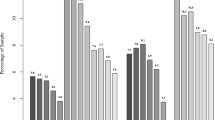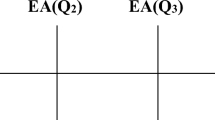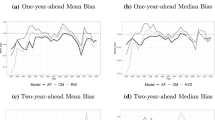Abstract
We find highly significant results when the cross-section of market-adjusted stock returns is regressed against changes in analyst expectations this year about: (1) this year's earnings, (2) next year's earnings, (3) long-term earnings growth, and (4) noise (measured as the standard deviation of analyst forecasts). Surprisingly, changes in expectations about this year's earnings are not significant in a multiple regression with the other independent variables. Changes in expectations about next year's earnings are highly significant but with an impact that is much smaller than that of changes in expectations about the long-term growth in earnings. Changes in noise are also statistically significant and are negatively related to market-adjusted returns, an indication that the signal to noise ratio, rather than merely the signal, is what drives price adjustments to new information.
Similar content being viewed by others
References
Abarbanell, J. S. (1991). “Do Analysts' Earnings Forecasts Incorporate Information in Prior Price Changes?” Journal of Accounting and Economics 14, 147–165.
Ackert, L. and G. Athanassakos. (1997). “Prior Uncertainty, Analyst Bias, and Subsequent Abnormal Returns.” Journal of Financial Research 20, 263–273.
Amir, E., B. Lev and T. Sougiannis. (1999). “What Value Analysts?” Working paper, New York University.
Ball, R. and P. Brown. (1968). “An Empirical Evaluation of Accounting Income Numbers.” Journal of Accounting Research 6, 159–178.
Bartov, E., D. Givoly and C. Hayn. (2000). “The Rewards to Meeting or Beating Earnings Expectations.” Working paper, Anderson Graduate School of Management, UCLA.
Bernard, V. and J. Thomas. (1990). “Evidence that Stock Prices Do Not Fully Reflect the Implications of Current Earnings for Future Earnings.” Journal of Accounting and Economics 13, 305–340.
Biddle, G., R. Bowen and J. Wallace. (1997). “Does EVA® Beat Earnings? Evidence on Associations With Stock Returns and Firm Values.” Journal of Accounting and Economics 24, 301–336.
Biddle, G. and G. Seow. (1991). “The Estimation and Determinants of Association Between Returns and Earnings: Evidence from Cross-Industry Comparisons.” Journal of Accounting, Auditing and Finance 6, 183–232.
Black, F. (1986). “Noise.” Journal of Finance 41, 529–544.
Brown, S. and J. Warner. (1980). “Measuring Security Price Performance.” Journal of Financial Economics 8, 205–258.
Bowen, R., D. Burghstahler and L. Daley. (1986). “Evidence on the Relationships Between Earnings and Various Measures of Cash Flow.” The Accounting Review 61, 713–725.
Bowen, R., D. Burghstahler and L. Daley. (1987). “The Incremental Information Content of Accrual Versus Cash Flows.” The Accounting Review 62, 723–747.
Chen, N. F. (1983). “Some Empirical Tests of the Theory of Arbitrage Pricing.” Journal of Finance 38, 1393–1414.
Collins, D. et al. (1994). “Lack of Timeliness and Noise as Explanations for the Low Contemporaneous Return-Earnings Association.” Journal of Accounting and Economics 18, 289–324
Copeland, T. E. and D. Friedman. (1992). “The Market Value of Information: Some Experimental Evidence.” The Journal of Business 67, 241–266.
Cornell, B. (2001). “Is the Response of Analysts to Information Consistent with Fundamental Valuation? The Case of Intel.” Financial Management Spring 2001, 113–136.
Cornell, B. and R. Roll. (1981). “Strategies for Pairwise Competitions in Markets and Organizations.” Bell Journal of Economics 12, 201–213.
Dechow, P., A. Hutton and R. Sloan. (1999). “An Empirical Assessment of the Residual Income Model.” Journal of Accounting and Economics 26, 1–34.
Dechow, P., R. Sloan and A. Sweeney. (1995). “Detecting Earnings Management.” Accounting Review 70, 193–225.
Degeorge, F., J. Patel and R. Zeckhauser. (1999). “Earnings Management to Exceed Thresholds.” Journal of Business 72, 1–33.
Diether, K., C. Malloy and A. Scherbina. (2002). “Differences of Opinion and the Cross-Section of Stock Returns.” Journal of Finance 57, 2113–2141.
Easterwood, J. and S. Nutt. (1999). “Inefficiency in Analysts' Earnings Forecasts: Systematic Misreaction or Systematic Optimism?” Journal of Finance 54, 1777–1797.
Easton, P. and T. Harris. (1991). “Earnings as an Explanatory Variable for Returns,” Journal of Accounting Research 29, 19–36.
Fama, E. (1998). “Market Efficiency, Long-Term Returns, and Behavioral Finance.” Journal of Financial Economics 49, 283–306.
Fama, E. and K. French. (1992). “The Cross-Section of Expected Returns.” Journal of Finance 47, 427–465.
Feltham, G. and J. Ohlson. (1995). “Valuation and Clean Surplus Accounting for Operating and Financing Activities.” Contemporary Accounting Research 11, 689–731.
Freeman, R., J. Ohlson and S. Penman. (1982). “Book Rate of Return and the Prediction of Earnings Changes: An Empirical Investigation.” Journal of Accounting Research 20, 639–653.
Foster, G., C. Olsen and T. Shevlin. (1984). “Earnings Releases, Anomalies, and the Behavior of Security Prices.” The Accounting Review 59, 574–603.
Gleason, C. and C. Lee. (2003). “Analyst Forecast Revisions and Market Price Discovery.” The Accounting Review 78, 193–225.
Granger, C. W. J. (1969). “Investigating Causal Relations by Econometric Models and Cross-Spectral Methods.” Econometrica 37, 424–438.
Hong, H., T. Lim and J. Stein. (2000). “Bad News Travels Slowly: Size, Analyst Coverage, and the Profitability of Momentum Strategies.” Journal of Finance 55, 265–295.
Hunt, A., S. Moyer and T. Shevlin. (2002). “Earnings Volatility, Earnings Management and Equity Value.” Working paper, University of Washington.
Jones, C., H. Latane and R. Rendleman. (1982). “Empirical Anomalies Based on Unexpected Earnings and the Importance of Risk Adjustments.” Journal of Financial Economics 10, 269–287.
Keim, D. (1983). “Size-Related Anomalies and Stock Return Seasonality: Further Empirical Evidence.” Journal of Financial Economics 12, 13–32.
Kothari, S. P., J. Shanken and R. Sloan. (1995). “Another Look at the Cross-Section of Expected Returns.” Journal of Finance 50, 185–224.
Lim, T. (2000). “Rationality and Analyst Forecast Bias.” Journal of Finance 55, 369–385.
Liu, J. and J. Thomas. (2000). “Stock Returns and Accounting Earnings.” Journal of Accounting Research 38, 71–102.
Lopez, T. and L. Rees. (2001). “The Effect of Meeting Analysts' Forecasts and Systematic Positive Forecast Errors on the Information Content of Unexpected Earnings.” Working paper, Texas A&;M University.
Lundholm, R. and L. Myers. (2002). “Bringing the Future Forward: The Effect of Disclosure on the Returns-Earnings Relation.” Journal of Accounting Research 40:3, 809–839.
Matsumoto, D. (2002). “Management's Incentives to Avoid Negative Earnings Surprises.” Accounting Review 77, 483–514.
Myers, L. and D. Skinner. (1999). “Earnings Momentum and Earnings Management.” Working paper, University of Michigan.
Penman, S. (1996). “The Articulation of Price-Earnings Ratios and Market-to-Book Ratios and the Evaluation of Growth.” Journal of Accounting Research 34, 235–259.
Samuelson, P. (1965). “Proof that Properly Anticipated Prices Fluctuate Randomly.” Industrial Management Review 6, 41–49.
Stewart, G. B. (1991). The Quest for Value. New York: Harper Collins, Inc.
Author information
Authors and Affiliations
Corresponding author
Rights and permissions
About this article
Cite this article
Copeland, T., Dolgoff, A. & Moel, A. The Role of Expectations in Explaining the Cross-Section of Stock Returns. Review of Accounting Studies 9, 149–188 (2004). https://doi.org/10.1023/B:RAST.0000028184.06279.57
Issue Date:
DOI: https://doi.org/10.1023/B:RAST.0000028184.06279.57




